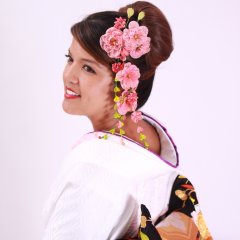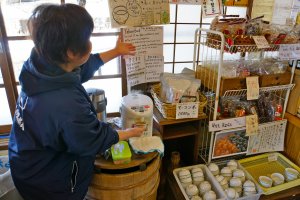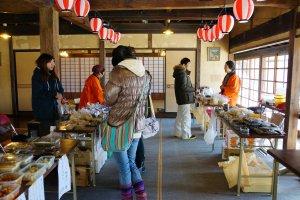Nestled among the base of the mountains in Yamanashi Prefecture is a charming village called Saiko Iyashino-Sato Nenba. Also known as “Healing Village,” the community is comprised of 22 traditional thatched roof houses that depict old-time scenery of the Showa Period (1926-1989). Each house highlights traditional Japanese culture through hands-on experiences such as crafts, sampling of local produce, and an opportunity to dress up in armor or kimono. In winter, snowfall transforms the village into a magical, fairytale-like landscape that commands a magnificent view of Mt. Fuji like no other!
The restored area of Nenba is just on the northwest end of Lake Saiko. It was once a dignified settlement with thatched houses of “Kabuto-zukuri,” or roofing designed like a samurai warrior helmet, until it was devastated by a typhoon in 1966. Today, revived Nenba thrives with culture and a natural environment that ties into the regions history. The village name Saiko Iyashino-Sato Nenba was born in 2006.
In the wintertime, the village opening hours during the months of December to February are 9:30am-4:30pm (closed Wednesdays). From March to November, the village operates 7 days a week from 9:00am-5:00pm. Due to the number of houses onsite, you can easily spend an entire day here.
Plan ahead! Here is a complete list of houses featuring traditional Japanese culture and a therapeutic experience you will cherish for years to come:
- Wazenya Saiun. A local Japanese restaurant that specializes in seasonal local cuisine and homemade sweets, with a spectacular view of Mt. Fuji.
- Water Mill. Rarely seen these days, buckwheat, wheat, or rice is grounded here.
- General Information Desk. Tourist information and various bookings are available here.
- Local Produce Processing and Marketing Center. Local specialties, pickles, miso (bean paste), rice cakes, etc. are sold here. Enjoy a complimentary cup of tea!
- Kutsurogi-ya (House of Relaxation). Matrons from the local community cordially welcome guests. Sometimes used for special events.
- Seseragi-ya (House of Babbling Brook). Rustic crafts indispensable for rural life are produced here. On Sundays of March to November, visitors can learn how to make a letter picture.
- Erosion and Sediment Control Museum. An exhibit of anti-erosion works, documents, visual data, and dioramas related to the 1966 typhoon that devastated Nenba.
- Charcoal Kiln: A reproduction to educate visitors on charcoal making. Charcoal was once the main industry of Nenba area.
- Gorone-kan (House to lay down and doze off). A house comprised of a recreation room for small concerts and four inviting, cozy rooms.
- Takumiya (House of Meisters). This house holds short-term exhibitions of remarkable industrial artists in Yamanashi Prefecture.
- Miharashi-ya (House with a view). Distinctive or prize-winning craftworks from the town and the prefecture are on exhibition here with a splendid view of Mt. Fuji.
- Hinomi-ya (Fire-watch house). The ground floor holds a special collection of armor and kimono called, “Armors and the Periods.” The second floor houses the armor of Civil War Period Commander, Takeda. For 500yen, try on kimono or samurai armor and take your own photos with Mt. Fuji as your backdrop. Arrive early to avoid the long lines.
- Kayanuma House of Pottery and Incense. Hands on experience of pottery and incense making from fragrant pieces of wood.
- Kami-ya Sakate Sanbo (Japanese paper workshop).
- Rest station
- House of Oishi-tsumugi & Fabrics. Hand-weaving of Yamanashi’s traditional craftwork, Oishi-tumugi, and making of trinkets using cocoons.
- Pottery Workshop Fuji Roman-gama. Make an owl figure and paint on fired biscuits before it is glazed. Fun for all children.
- Crepe-cloth Works & Hanging Decorations. Mobile ornaments are displayed here and visitors can try making fancy goods in Japanese cloths.
- Omoide-ya (House of memories). Local specialties and handmade crafts are introduced and sold here.
- Shokujidokoro Satoyama (Regional restaurant). Bright, flavorful, seasonal food with a hometown taste, made from local ingredients. Try Houtou, hand rolled Udon.
- Stone-ground Soba Noodles – Shosen. This shop’s handmade noodles are highly ranked at a nation-wide soba popularity poll. Reservations for groups of up to 60 persons are available.
- Old House of the Watanabes. A private folk dwelling was renovated to re-create the time when the silk cultivation was thriving.
Admission fees are Adult 350yen and Children 150yen. Approximately 20 minutes from Kawaguchiko Station. Parking is free.



































